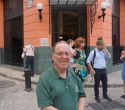The Old Man and the Sea (Hemingway wrote that here, and I’ll get to him at the end)
I mentioned yesterday that the other number that struck me as being important was 11000000. That’s the population of Cuba. As much as the comparisons circle in my mind comparing my first visit to China (1990) or the early 1990s with my first visit to Cuba a quarter of a century later, the comparisons turn increasingly into contrasts. Despite the presence of two currencies and a centralized economy,based on central planning, there was no Tiananmen Square here, no obvious police or party state, and a gemutlichkeit that is not necessarily attributable to tourists (although, as I mentioned, the tourist invasion is here).
The businesses and academics we visited with yesterday and today have broadly outlined the challenges (sometimes with sugar coating), and their potential response. Perhaps the biggest is the difference between a country of 1.2 billion (China) and a country of 11 million, about 20% of whom are over the age of 50. For a variety of reasons, including emigration, the birth rate is down, and the bootstrapping of a young labor force that propelled the economic development of China, is not going to happen in Cuba. The emphasis, we were told, that the government would love to insure, is on the development of a knowledge-based society. While the Cubans are literate (98%+ according to some of our sources), the goal is seemingly that of every developed and developing country
Part of the problem is the scarcity of capital. Indeed, one of the traits I realized in reading Jack Ma’s biography, and the book on Airbnb and Uber (the “Upstarts”) is the relative ease with which those startups were able to raise “angel funds.” (Goldman Sachs gave Ma $30 million for Alibaba). That is not the case in Cuba, where the US embargo hurts. In addition, I raised the question of the overseas Chinese, overseas Vietnamese, and overseas Indians, all of whom have been critical in assisting those nations in moving up in development. Three million Cubans live elsewhere (including 2 million in the United States), and many of them are wealthy; the answer, the professors gave me, was that giving them privileges would be “dealing with traitors” and negating the sacrifices made for the revolution. Mulling over the answer, I think about what happened in China, where the bitterness of the Kuomintang defeat (or the Communist victory) lasted until the death of Mao and Chiang, and required the move of Deng Xiao-ping to give special economic zones to Xiamen (across from Taiwan) or to Singapore Chinese in Suzhou, etc. Locals have, however, told us how much change has occurred in the last five years here, which they attribute to Obama.
Today was a combination of history and business, and the two are related. Cuba, again, the professors insisted, had been too reliant on a single market. Spain, as part of Spanish colonial policy, that tried to funnel all the wealth of the colonies through the mother country—Seville was the first major source of finished Cuban tobacco; then the United States, partly by proximity, and partly through dollar diplomacy, and the protectorate that lasted more or less through 1959, and finally the Soviet Union.
What does Cuba have to share with the world?
We have had a chance to look at three of the major income generators in Cuba—tourism, and the agricultural products, tobacco and rum—the major cash crops of Cuba today.
We went to the Melia hotel for a talk with two of the executives. The pattern there is what we saw in the other businesses as well; a foreign (not US) company brought in for its expertise (in this case management) to run hotels owned and built by one of three major government agencies. The spike in tourism, especially from Americans, has had some interesting consequences. The lack of adequate housing led to a classic supply and demand situation, when hotels raised their prices. Tour operators, in turn, had to raise their prices by between 500 and 1000 dollars, which led to cancellations. That was one consequence. Another was the approval to build more hotels including a new one in the old town that will decrease the Nacional to the 4th most expensive. And a third (semi encouraged by the government) was the arrival of the shared economy: i.e., airbnb, an arrival greeted with hostility by our presenters. There’s also a fourth response, as I think I mentioned last night—and that’s the return of the cruise ships to Cuban waters.

Interestingly, at the Havana Club museum (how to make rum), they mentioned the great growth in tourism and rum during Prohibition. One of the Club Ron (as it was known in those days) advertisements noted, “Just a Hop from Miami,” and I can only imagine the decadence of the period from  the buildings we saw on our tour of the old city. We stopped at the end of the day for refreshments and music at a bar Hemingway used to frequent. His daily diet was either 12 mojitos (the local drink offered to guests and served at meals) or 8 daiquiri. None of us followed his example, I’m happy to say.
the buildings we saw on our tour of the old city. We stopped at the end of the day for refreshments and music at a bar Hemingway used to frequent. His daily diet was either 12 mojitos (the local drink offered to guests and served at meals) or 8 daiquiri. None of us followed his example, I’m happy to say.
We’ll visit a tobacco field tomorrow, so I’ll save what I have to say after that trip. I still want to get back to the old city later this week; you know I love forts and churches, and Cuba, as one of the rich colonies in the Spanish empire, needed to have both.